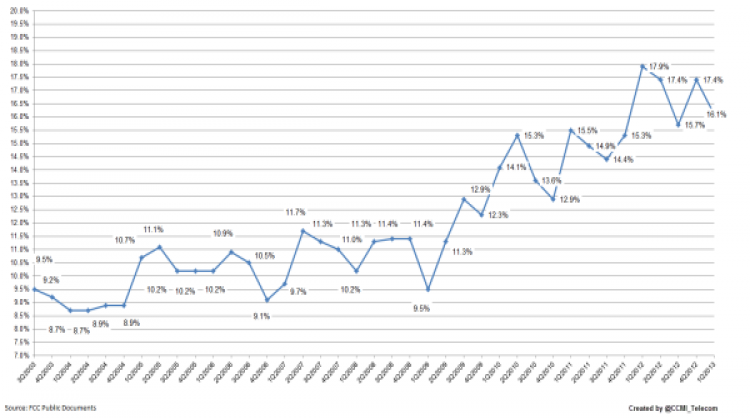Doubling Down on Universal Service Fund (USF)
February 2, 2013 | by George David

Every once in a while, it pays to dismiss – or at least discount – policy arguments and look at the cold, hard facts. So, while the FCC’s interminable deliberations on Universal Service Fund (USF) reform continue consider this: in just under 10 years, the USF contribution rate has doubled. That’s right, doubled.
In the fourth quarter of 2003, the USF contribution rate was 8.7% – a number that at the time seemed extraordinarily high. In the fourth quarter of 2012, the USF contribution rate hit 17.4% – a 100% increase from 2003!
Click the image to view a larger version.
Currently, the FCC proceeding is locked into arguments over methodology. And if you look through and read the comments of all the stakeholders – and there are many – you can find compelling arguments for a methodology based on telephone numbers, or network connections, or a modified version of today’s revenue-based formula. But while the industry argues, consumers and business users continue to pay a high price because carriers routinely pass along USF charges to them while the FCC debates. And as VoIP, texting, and email continue to grow in popularity, the traditional TDM wireline base that funds USF shrinks. Translation: absent FCC action, the current 17.4% rate will only go up … and the rate of increase will accelerate as more and more consumers and businesses (who are setting the pace on this) abandon TDM wireline services for communications services that use the internet.
Perhaps it’s the water in Washington, because the leadership and political will to fix USF is in the same short supply as the politicians' willingness to tackle (pick your poison) entitlement reform, the debt ceiling, sequestration, whatever. So the easy route is to “kick the can” down the road through a seemingly endless rounds of industry comment. But while that happens, the current high, and probably going higher, contribution rate is a dark cloud for consumers and enterprise users.
So here are a few (maybe radical) thoughts to move the process along:
- Take a close look who receives USF funds and why. No one disputes the Fund exists for valid reasons, but like most long-entrenched programs, whether in the public or private sector, a fresh look is always a good idea.
- Cap the rate at its current level, and reduce it by a set percentage each quarter, to force a more reasoned and rational allocation of increasingly scarce dollars.
- More and more, VoIP, texting, and Over-the-Top (OTT) services like Skype are the way people communicate today and – given broadband access and availability – are clear substitutes for each other, and for TDM wireline service. Treat them all equally to increase the pool of contributors.
- Currently, interstate revenues are the basis for USF contributions. But the distinction between interstate and intrastate services is meaningless when the internet comes into play, so stop the charade and have all revenue count toward the USF. An added bonus: it obviates the need for the USF-like mechanisms that exist in most states.
Am I confident any of this will happen? The only way the FCC will pick up the pace is when consumers and enterprise – the folks who pick up the tab – put concerted, sustained pressure on the FCC. And with continued upward pressure on the contribution rate, let’s hope that happens soon.
Easily stay up to date on this subject by subscribing to our blog. We'll update this graph and provide insight on any federal actions regarding the universal service fund quarterly.



